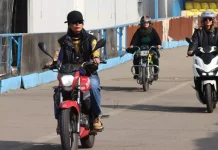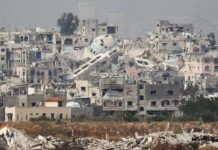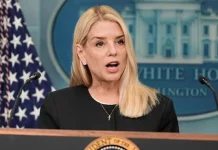KABUL: As the end to America’s “forever war” rapidly approaches, the U.S. Embassy and other diplomatic missions in Kabul are watching a worsening security situation and looking at how to respond.
In the countryside, districts are falling to the Taliban in rapid succession. America’s warlord allies are re-arming their militias, which have a violent history, raising the specter of another civil war once the U.S. withdrawal is finished, expected in August.
A U.S. Embassy spokesperson told The Associated Press that security assessments are frequent these days. Speaking on condition of anonymity in line with briefing rules, she said the embassy is currently down to 1,400 U.S. citizens and about 4,000 staff working inside the compound the size of a small town.
A well-fortified town, that is. Besides its own formidable security, the embassy lies inside Kabul’s Green Zone, where entire neighborhoods have been closed off and giant blast walls line streets closed to outside traffic. Afghan security forces guard the barricades into the district, which also houses the Presidential Palace, other embassies and senior government officials.
The only route out is Kabul’s Hamid Karzai International Airport, currently protected by U.S. and Turkish troops.
Before America can declare its war over, the security of the airport will have to be settled. Ankara is in talks with Washington, the United Nations and the Afghan government to decide who will protect the airport and who will foot the bill.
For now, the airport is running without interruption, except for restrictions imposed by a deadly third COVID surge that has prompted some countries to suspend flights to Kabul. However, India is not one of them — as many as eight flights arrive weekly from India — and as a result, the virus’ delta variant, first identified in India, is rampant in Afghanistan.
In Kabul, it’s common to hear speculation about when and if the U.S. Embassy will evacuate and shut down, with images resurrected of America’s last days in Saigon at the end of the Vietnam war.
Already, long before the last U.S. and NATO troops began packing to leave, American diplomats arriving at the airport were taken to the heavily fortified U.S. Embassy by helicopter. The 4-mile road trip through Kabul’s chaotic traffic was considered too dangerous.
Suicide bombers struck along that road with uncomfortable frequency.
For many of Washington’s new diplomats to Afghanistan, their view of the country and Kabul is limited to what they see from the confines of the sprawling embassy compound, hidden deep inside the Green Zone and protected by 10-foot blast walls, heavily armed U.S Marines, explosive-sniffing dogs and cameras at every corner.
An American employee of Resolute Support, the name of NATO’s military mission in Afghanistan, who arrived in the country last November, had not been outside the giant gates of the mission by June.
Citing security concerns, the U.S. spokesperson said she couldn’t reveal evacuation plans, or even if that’s a part of today’s conversation, but said the embassy has detailed plans for every scenario to protect its staff. If there is an evacuation, it wouldn’t be the first. – Agencies






